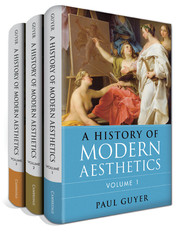Book contents
- Volume 1 The Eighteenth Century
- Volume 2 The Nineteenth Century
- Volume 3 The Twentieth Century
- Frontmatter
- Contents
- Acknowledgments
- Introduction
- Part One German Aesthetics in the Twentieth Century
- Part Two Aesthetics in Britain until World War II
- Part Three American Aesthetics in the First Half of the Twentieth Century
- Part Four Wittgenstein and After
- Bibliography
Part One - German Aesthetics in the Twentieth Century
from Volume 3 - The Twentieth Century
Published online by Cambridge University Press: 05 June 2015
- Volume 1 The Eighteenth Century
- Volume 2 The Nineteenth Century
- Volume 3 The Twentieth Century
- Frontmatter
- Contents
- Acknowledgments
- Introduction
- Part One German Aesthetics in the Twentieth Century
- Part Two Aesthetics in Britain until World War II
- Part Three American Aesthetics in the First Half of the Twentieth Century
- Part Four Wittgenstein and After
- Bibliography
Summary
German writers dominated the field of aesthetics in the late eighteenth and most of the nineteenth centuries, and their prominence in the preceding narrative, in the last part of Volume 1 and through much of Volume 2, has reflected that fact. German intellectual life, indeed German life in general, was repeatedly disrupted in the twentieth century, by the First World War, by the rise of National Socialism and the Second World War and the enforced emigration or destruction of many professors and writers, largely but not exclusively Jewish, that accompanied those events, and then by the division of the nation and the Cold War that followed; and German philosophy including aesthetics was not excepted from all these upheavals. But in spite of and to some extent because of all these disruptions, as well as because of the tradition of German aesthetics over the preceding two centuries, debate over the nature and value of the arts and of experience of them remained lively throughout the twentieth century. In order to make room for the extensive development of aesthetics in twentieth-century Britain and the United States, our survey of twentieth-century German aesthetics will have to be even more selective than were our surveys of eighteenth- and nineteenth-century German aesthetics. But we will nevertheless consider a number of the most important German (or German-writing) aestheticians of the twentieth century, including Georg Lukács and Martin Heidegger (although not others in Germany, France, or Poland who hewed more closely to the original phenomenology of Heidegger’s teacher Edmund Husserl), whose views were formed in the period between the two world wars, and who may to some extent be taken as representing left- and right-wing thought during those years, and then Hans-Georg Gadamer, Theodor W. Adorno, and Herbert Marcuse, who although they to some extent carried on the interwar debates, published their most important works after the Second World War, and, at least in the case of Gadamer and Marcuse, in spite of both having begun as students of Heidegger, introduced a new theme, or reintroduced an old one, into twentieth-century German aesthetics, namely, the idea of play. We will also briefly consider several more contemporary German figures, including Dieter Henrich, in turn the foremost student of Gadamer.
- Type
- Chapter
- Information
- A History of Modern Aesthetics , pp. 7 - 8Publisher: Cambridge University PressPrint publication year: 2014



